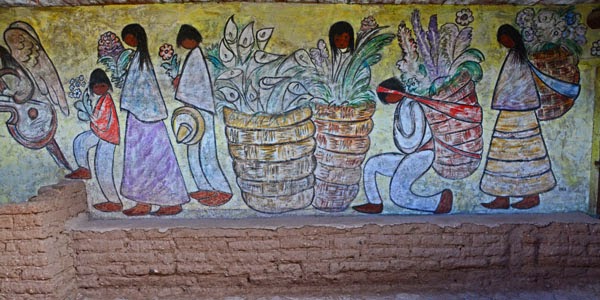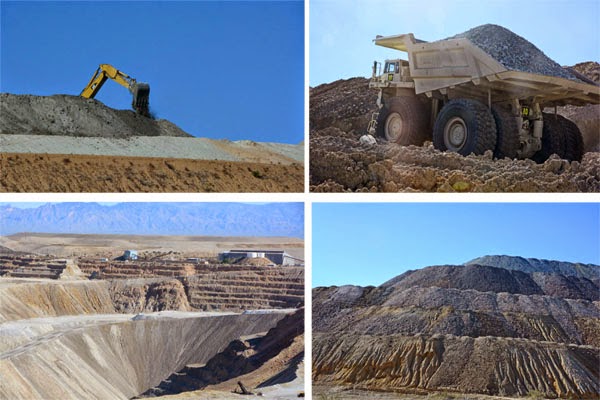We left Nogales at 12:35 PM on Wednesday,
3/4/15 and drove north on I-19 about 16 miles to
Tumacácori
National Historic Park, (Tomb-a-c
ock-or-ee)
which preserves an old Spanish mission church, San Cayetano de Tumac
ácori, founded in 1691 by
Padre Eusebio Francisco Kino, known as the “Padre on Horseback.”
The original mission location was moved from
the east banks of the Santa Cruz River to the west bank of the river in 1751
after devastating Indian attacks and the name was changed to San José de Tumac
ácori.
The Presidio of Tubac was established in
1752, about 10 miles north, with 50 Spanish soldiers to protect the area from
Indian raids.
Tumacácori
never had a resident priest since it was a visita of Mission San Gabriel de
Guevavi, 12 miles away. A small adobe
Jesuit church was erected at Tumacácor
in 1757 on a nearby site and survived for 65 years. International politics were about to raise
its ugly head when in 1767 the Spanish King expelled the Jesuits from all
Spanish territories and replaced them with the Franciscan order. In 1771, Tumacácori
became mission headquarters and gained a resident priest for the first
time. The church property was walled-in,
adobe dwellings were built for the Indians and the church was refurbished with
new decoration in and out. In 1787, Guevavi and another visita, Calabasas, were
abandoned due to Indian attacks and dispersal of its Indian converts.
About 1800 Fray Narciso Gutierrez, a Franciscan, began
construction of the present larger church, built and decorated like the larger
church of San Xavier del Bac close to Tucson.
In the next years, funds ran out and construction stopped but Indian
attacks continued, and in 1801, an Apache attack wiped out most of Tumac
ácori's livestock.
The Mexican War of Independence from Spain
was won in 1821 and church construction resumed, but Spain cut off all funds and
work stopped again.
Final phases of
construction resumed in 1823, but in 1828, Mexico deported all Spanish-born
residents leaving only Mexican priests, who were already scarce.
Tumac
ácori
once again was a visita, with no resident priest!
Next political crisis was in 1848 during the Mexican-American
War plus stepped up Apache attacks and a very hard winter caused the Tubac
Presidio and Tumac
ácori
to be abandoned 157 years after Padre Kino founded the Mission.
In 1853, the Gadsden Purchase put Tumac
ácori inside the United
States border.
In 1908 Tumac
ácori National Monument was
created by Congress to preserve this historic site including the legacy of
Padre Kino!
In 1990 Congress added the
closely related, but unfortunately very deteriorated, sites of Guevavi and
Calabasas to create
Tumacácori
National Historic Park. The remains
of the Tubac Presidio are protected as
Tubac Presidio State Historic Park
by the State of Arizona.
We were
fortunate to take an excellent free guided tour of the Tumac
ácori church, outbuildings
and the newly restored orchard!
Visiting
takes you back through almost 325 years of Spanish borderlands history!
 |
| A little bit of the colorful murals is still visible |
 |
| In the Museum was a small diorama how the church looked in the 18th century |
Tubac today has turned into art colony of sorts with many
shops, cafes and of course, the state park.
We spent a pleasant night at the Mountain View RV Ranch in
Amado, a few miles north of Tubac.
The goal was to get an early start the next morning so we
could be on the 9AM first tour of the day at the
ASARCO Mineral Discovery
Center in Sahuarita.
The tour of the
ASARCO Mission Mine, one of the largest open pit copper mines in Arizona, was
excellent with a terrific guide!
It
started with a bus ride up to a high overlook of the gigantic open pit copper
mine, where we could watch the drills, shovels loading the huge haul trucks
that bring the ore to the mill in 320 ton truck loads!!
After 15 minutes at the pit, the bus took us
to the mill where we could see the crushers, ball mills and wet grinding mills
that grind up the raw ore that's only 0.4% copper and concentrate it by flotation
to a powder consistency that is 25-30% copper!
The two huge mill facilities here process a total of about 54,000 tons a
day!
 |
| Left bottom: flotation process--mixed with pine oill bubbles seem to light up |
This concentrate is trucked to ASARCO's Hayden refinery where
it becomes large 99.9% copper anodes!
65% of all the copper produced in the United States comes from
Arizona.
In addition to copper, this
mine also produces enough gold and silver to pay its huge electric bill!
This Mission mine began operations in 1961
and is named after nearby Mission San Xavier del Bac, the most famous and best
preserved of all the Kino missions.
The
Mission mine facility provides the only public mine tours in Arizona and sees
about 20,000 visitors per year.
At the entrance to the parking lot we saw this huge cristate saguaro cactus.
Mission San Xavier del Bac
After leaving the mine, we drove north about
9 miles to
Mission San Xavier del Bac, near
Tucson.
This mission was founded by
Padre Eusebio Francisco Kino in 1692 at the large Pima Indian village of Bac,
now called Wa:k. As usual, it started with a small adobe chapel but since a
resident priest was not available, it was only visited occasionally.
The foundations for a larger church were laid
by Padre Kino in 1700, but lay vacant for a decade because of the death and
sickness of assigned padres and perhaps was never finished. It's a sad fact
that almost all of the original churches that Padre Kino personally planned and
built were gone in 25 years or less, due to Indian raids and natural disasters
such as earthquakes and floods.
In 1751,
the Pima Revolt resulted in the burning and pillaging of the church.
Another adobe church was built in 1756, and
its foundations are still visible 40 yards to the west of the present
church.
After the Jesuits padres were
exiled and the Spanish Franciscans took charge in 1768, San Xavier became the
headquarters for Fray Francisco Garces and later Fray Juan Bautista
Velderrain.
In 1783 Padre Velderrain began building the current Church
with money borrowed from a Sonoran rancher, and construction was completed in
1797.
The architect was Ignacio Gaona,
who also designed the Church at Caborca, Sonora.
The workers were a large group of the O'odham
or Pima Indians.
The Church was built
with fired adobe in the form of a cross with the interior over eighty feet
high! With Mexican Independence in 1821, San Xavier became Mexican, not
Spanish. The last resident Franciscan left in 1837.
With the Gadsden Purchase of 1854, San Xavier
became a part of the United States!
In
1859, the Diocese of Santa Fe, New Mexico took charge and began repairs to the
Mission.
In 1866, the Diocese of Tucson
was formed and San Xavier became part of the new diocese.
Regular Mass began again.
The Mission School opened in 1872 with the
Sisters of St. Joseph of Carondelet teaching. From 1940 to the present, the
Franciscan Sisters of Christian Charity teach at the K-8 school and reside in
the Convent.
A violent earthquake in
1877 damaged walls and structures of the Mission. The Franciscan friars
returned to San Xavier in 1913.
In 1905, Tucson Bishop Granjon took a personal interest and
began major repairs to stabilize all the structures of San Xavier.
Then in 1939, lightning struck the west tower
of the church requiring more repair.
More recently, in 1953 the Mission facade was restored and then in 1963,
San Xavier was designated a National Historic Landmark.
An organization that we personally support,
Patronato San Xavier, was formed in 1967 to preserve the structures of San
Xavier, both interior and exterior.
Patronato funded an extensive 5 year interior restoration and
conservation project that brought highly skilled international conservators to
the Mission to restore the interior paintings, the retablo, saints and angels
and the interior decorative painting on the walls.
A masterful restoration was accomplished to international acclaim. The next project starting very soon will be
the restoration of the east tower of the Church.
Today, Mission San Xavier del Bac is
considered the finest example of Spanish Colonial architecture in the United
States.
The interior is absolutely
glorious with gold and silver leaf, wonderful warm colors, and over 50 saints
in niches around the church.
A reclining
San Francisco Xavier figure in the west transept draws many pilgrims to the
Mission and many prayers for relief from diseases and accidents have been
acknowledged.
The east transept contains a beautiful shrine to Mary, mother
of Jesus and the patron saint of Mexico, Our Lady of Guadalupe.
Hundreds of angels are everywhere in the
Church.
The altar is a masterpiece of
Mexican baroque and Churrigueresque design. It is thought that most artwork in
the Mission was created in the church workshops of Quer
étaro,
Mexico and brought to the Mission on the backs of donkeys!
There is an excellent Mission Museum, a 20
minute history video and a very complete gift shop which even sells O'odham
baskets and other crafts. San Xavier is still a working Catholic parish church
with daily Masses and other services for its O'odham parishioners.
Each year, over 200,000 visitors drive nine
miles from Downtown Tucson to the Tohono O'odham Reservation to visit Mission
San Xavier del Bac!
The Mission is an
inspiring place to visit and to study the amazingly beautiful craftsmanship
lavished on this Church, which is still being carefully preserved for the
future!





























































